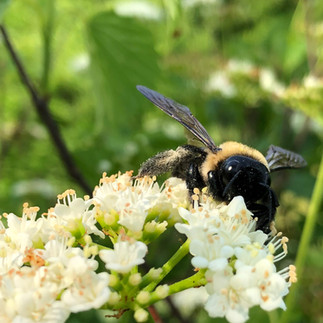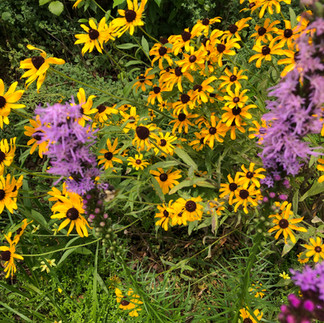What this means for your yard: Can you give up the “perfect lawn”?
October 1, 2021

It’s October, and Maryland has a new law, one that will help the environment and give us gardeners a little more freedom. Earlier this year, the Maryland legislature passed HB322, known as the Low-Impact Landscaping bill, effective October 1, 2021. In a nutshell, communities—including homeowners associations (HOAs)—can no longer require turf in yards or ban certain types of gardens.
Instead, the new law allows homeowners to convert their lawns to habitats to benefit pollinators, birds and other wildlife and to install rain gardens and xeriscaping to help manage storm water run-off and conserve water. Yes, even in our front yards. (Jump to types of gardens referenced in law).
This may mean that our expanses of uniform green lawn may change. But that’s a trend that has been gathering steam across the country for years as our planet faces drought, climate and biodiversity crises.
Here’s a sampling of the headlines: “Are Traditional Lawns on Their Way Out?” Wall Street Journal; “Do You Have a Glossy, Green Front Lawn? What is this, the 1950s?” The Guardian; “The American Lawn: A Eulogy,” The Atlantic. Heck, even Men’s Journal has been reporting on “How to Kill Your Lawn” and claims that “smaller is better.”
We’re still in the early phases of a mass shift away from lawns, however. For many, grass is a hard habit to break.
The truth about turf

Consider this: In the quest for perfect turf, we’re damaging our own health and the planet’s (plus our pets). To keep our lawns green and weed-free, each year Americans spend over $40 billion and apply nearly 60 million pounds of hazardous pesticides (this includes herbicides). Watering our lawns and gardens accounts for 1/3 of residential water use - nearly 9 billion gallons a day, according to the EPA.
Why? Since the 1950s—with the advent of the suburbs and manufacturing companies seeking out new markets for their chemicals after the Second World War—we’ve been programmed to nurture grass. It gets fed, watered, dressed, treated and cut on a routine schedule which would make Dr. Spock proud. When it acts up or seems ill, it gets special care. All to the tune of 150 hours a year per lawn.
If grass reciprocated a bit more—say, prevented flooding from stormwater runoff, cleaned our air, or served wildlife—perhaps this hard work might be worthwhile.
But while non-native turf grass is Maryland’s number one crop, it doesn’t provide many rewards. It sure is great to play or picnic on, but do we need so much of it? And could we still enjoy our grass, if it didn’t look “perfect”? Would those violets or clumps of clover really interfere with our enjoyment? (Disclaimer: I love to sit barefoot in my grassy, imperfect backyard).
Our own Frederick County, Maryland, government promotes best management practices for our lawns and common areas in Laying Down the Lawn: Protecting Water Quality: "Is your lawn a healthy, diverse, green ecosystem, pleasant to the eye with low cost, and ecologically sound maintenance? Or is it an economic and environmental liability?" If the little yellow warning signs in front yards are any indication, I think the answer may be the latter. Furthermore, landscapers and property managers routinely overlook the hazards of pesticides and fertilizer. But it’s hard to tell if it’s because they’ve bought into the sales pitch that they’re safe and effective, or if they’re just trying to keep residents happy.
Weeds, after all, are one of the top resident complaints in many HOAs. Just this week in my neighborhood, I happened across my first “Weed Man” advertisement—it featured a Superman lookalike decked in green with a gold “W” on his chest. The dandelions stand no chance against this “superhero” armed with his goody bag of chemicals.
Photos of Villages of Urbana Pollinator Garden
Join the movement away from "perfect" grass
The good news is that there are many alternatives to all turf and nothing but the turf. And now, thanks to this law, more of us can implement them without fear of a citation and (hopefully) without disappointing our neighbors.

Low-impact landscaping—defined as “techniques that conserve water, lower maintenance costs, provide pollution prevention, and create habitat for wildlife”—can be dynamic and beautiful as they change with the seasons and do their job of providing ecosystem services. They can even add to the value of a home and neighborhood, as more home buyers seek out sustainable and affordable landscaping.
This legislation is timely, especially as conservation-based organizations and local governments call on property owners to reconsider their lawns. For example, Doug Tallamy, perhaps America’s most famous entomologist and creator of Homegrown National Park, asks Americans to add 20 million acres of native plants to their yards, bit by bit, neighbor by neighbor to regenerate biodiversity. The Bee City USA program certifies cities that have taken steps to provide habitat for our endangered native bees. Some states like Minnesota even pay cash by the square foot to replace lawn with native prairie. Closer to home in Maryland, the Montgomery County Rainscapes program provides rebates up to $7,500 for property owners who install rain gardens and other conservation practices that help reduce flooding. We would like to see Frederick County offer incentives in the future for property owners and have made this request to our county leaders.

In another bold move, Montgomery County, Maryland, recently banned the use of pesticides for cosmetic purposes for private lawns, playgrounds and other places where children play. They provide some startling reasons for this legislation, including that “exposure to certain pesticides has been linked to a host of serious conditions in children including pediatric cancers, decreased cognitive function, and behavioral problems such as ADHD.” Organic turf management programs which focus on aeration, overseeding, natural fertilizer when needed, and allowing grass to grow to 4 inches can still yield lush, green spaces.
Frederick County’s Climate Emergency Mobilization Workgroup report from September 2021 recommends that we follow in our neighboring county’s footsteps and limit pesticides when used for aesthetic reasons (see Recommendation 20 on pages 74-75 of their final report). In addition to the direct health hazards, the manufacturing and use of pesticides, fertilizer and primitive motors in lawn care equipment add to our climate problem. Our planet and communities would benefit instead, they suggest, from native regenerative landscaping.
Consider joining the movement for a safer lawn and creating your own eco-conscious garden or sustainable habitat, no matter how big or small. Be a natural superhero! In doing so, you’ll help protect pollinators and aquatic animals, improve the health of the Chesapeake Bay, reduce carbon dioxide—and perhaps save a few bucks, many hours of maintenance and your health in the long run. Continue reading for tips on how to get started or expand!
Photos from author's backyard
Low-impact landscaping details
HB322 still allows HOAs to set “reasonable design and aesthetic guidelines,” and anyone planning a new landscape should review their community’s codes and consult with the manager if policies have not yet been updated. Homeowners should create a garden plan and practice “cues to care” like weeding undesirable plants, keeping edges trimmed, and planting in layers to demonstrate to neighbors that a garden for wildlife is not synonymous with a wild or unmanaged one.
Here are the four different types of landscaping referenced in the law:
Bio-habitat garden
A garden that provides shelter and food for wildlife, including insects, birds, mammals and amphibians using species of plants which have high impact as a food source or host. Visit the Humane Gardener’s website for information and inspiration.
Pollinator garden
Designed with mostly native plants to attract, feed and shelter domestic and wild bees, butterflies, moths, bats, hummingbirds, flies and beetles. Plants should provide year-round food and shelter for pollinators at every stage of their life cycle. These gardens skip the pesticides and the fall cleanup, as most pollinators will hibernate over winter in leaves, plant stalks and stems and in the ground.
See Green Team Urbana under Resources for many different design ideas. See this Mid-Atlantic Region Guide for Pollinator Plants from the Xerces Society.
Rain garden
Shallow, saucer shaped depressions that temporarily hold and treat runoff and recharge groundwater. Pollutants like fertilizer and pesticide residue are trapped by the rich soil and root systems in the rain garden, permitting cleaner water to slowly soak down through the soil and rocky subsoil.
Xeriscaping
Xeriscaping is the practice of designing landscapes to reduce or eliminate the need for irrigation. Xeriscaped landscapes need little or no water beyond what the natural climate provides. They often feature plants that are known to be drought tolerant and usually incorporate hardscape materials like river rocks and Seneca chips to preserve moisture, but mulch and compost are good options too.
For some ideas for Maryland drought-resistant plants, see this document from the Maryland Department of Natural Resources, page 6.
More resources to help you plan an environmentally-friendly landscape
This is a tremendous resource for those interested in changing current guidelines in HOAs: Howard County and Columbia Association Residents and Representatives' document of suggested revisions for Columbia Association (CA) Village RACs and other HOAs based on principles established by the Master Gardener, the Master Naturalist and the Watershed Steward programs.
"The Challenge of Growing a Lawn in Maryland" by the University of Maryland Extension, updated September 9, 2021.
Guide to Passing Wildlife-Friendly Property Maintenance Orders by the National Wildlife Federation.
American Green: The Obsessive Quest for the Perfect Lawn (2006) by Ted Steinberg
Nature’s Best Hope by Douglas Tallamy (2020). A call to action and explanation for why we need to minimize turf, increase our native plantings, and start a Homegrown National Park.
“Native Plants for Wildlife Habitat and Conservation Landscaping” by the US Fish and Wildlife Service. Contains information on the native plants of this region, including their growing needs and which animals rely on them for food, shelter and to reproduce.
“Pesticide-free Lawn Care: How to avoid greenwashing and harmful pesticides in lawn care” by the Environmental Health Network on 8/26/21, including tips for how to read an MSDS label.
Visit Beyond Pesticides for information about current news, profiles of pesticides and how to start your own neighborhood campaign to limit pesticides.
Earth Sangha for carefully procured native plants and programs. The Earth Sangha operates a volunteer-based ecological restoration program for the greater Washington, DC, region. The program is designed to conserve and restore the native plant communities that are essential to the region's ecological health. At the heart of the program is ourWild Plant Nursery, the region’s most comprehensive source of native plants propagated from local, wild seed. In addition to local-ecotype native plant propagation, we help stabilize streams, control invasive alien plants, and restore forests, meadows, and wetlands.
Carey Murphy is a co-founder of Green Team Urbana and a Master Naturalist intern. She has a yard with native plants, trees, and ever diminishing turf.














